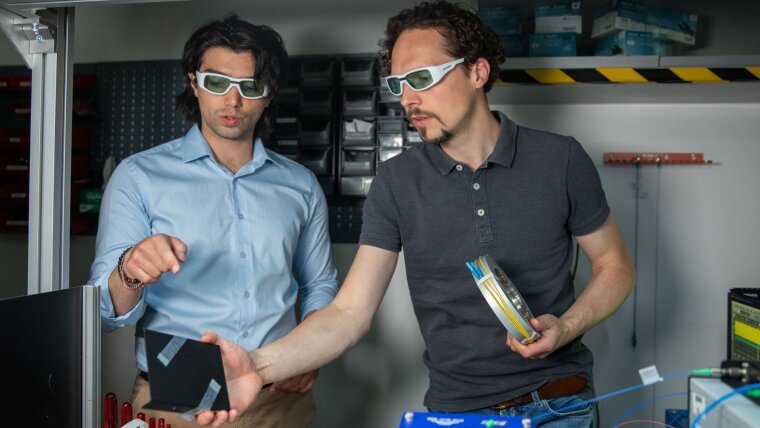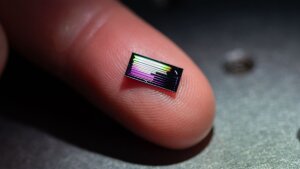
- Light
- Research
Published: | By: Lavinia Meier-Ewert
The photonic chip uses time-bin coding to transmit more information per photon.
Image: Stela Todorova/ Leibniz-IPHTWhether in medicine, government, or industry—anywhere highly sensitive data needs protection, quantum communication could play a vital role in the future. Instead of transmitting electric signals, this technology uses individual particles of light—so-called photons—that are entangled in specific quantum states. The key advantage: any attempt to intercept the communication alters the state of the photons, making unauthorized access detectable.
To bring quantum communication out of the lab and into real-world applications, several technical hurdles must still be overcome. An international team of researchers from Jena (Germany) and Canada has now tackled two of the most critical challenges: How can each photon carry more information? And how can the quantum signal remain stable over long distances despite the physical effects that occur as light travels through optical fiber?
The team presents its answers in two recent studies published in Nature Communications and Physical Review Letters. The researchers have developed innovative methods that significantly increase the information density per photon and enable stable quantum links across long distances—using technologies compatible with today’s fiber-optic infrastructure.
Photons as Data Carriers: Encoding Information in “Time Bins”
One central approach involves so-called time-bin encoding: Photons carry information based on their precise arrival time—i.e., the tiny time window (“time bin”) in which they are detected. Until now, only two such windows could typically be distinguished. The researchers have now developed a photonic platform capable of using up to eight time bins per photon simultaneously, thereby significantly increasing the data rate.
“You can think of it like a drawer system,” explains Prof. Dr. Mario Chemnitz from the Leibniz Institute of Photonic Technology (Leibniz-IPHT) and Friedrich Schiller University Jena. “Instead of opening just one drawer, we can now open several at once—allowing more information to be transmitted simultaneously.”
This platform, developed as part of the Nature Communications study, was jointly led by the Institut National de la Recherche Scientifique (INRS) in Canada and Leibniz-IPHT. It uses a custom-designed photonic chip made of silicon nitride, a material particularly well suited for guiding light on a compact, integrated scale. The chip’s microscopic interferometers generate and process entangled photons and rely on standard telecom components. The system was successfully tested over 60 kilometers of optical fiber—equivalent to the distance between typical network nodes. In the future, this could enable more users to communicate simultaneously, securely, and at higher data rates.
Stable Quantum Links Over Long Distances
The second major challenge is distance: as the transmission length increases, the signal becomes more vulnerable—especially to dispersion, a physical effect that spreads out light pulses in time. This complicates the precise discrimination of time bins. In their second study, published in Physical Review Letters, the team demonstrated how this issue can be overcome: Instead of analyzing only the time difference between photon pairs, they measured their joint arrival time. This so-called sum-frequency correlation remains stable even under strong dispersion and has now been purposefully exploited for the first time.
As a result, the team extended the effective range of an encrypted quantum connection to the equivalent of 200 kilometers of fiber—while maintaining higher signal quality and security.
“The first study shows how we can transmit more information per photon. The second shows how to keep that information reliable across real-world fiber networks,” Chemnitz explains. “Together, these results bring us closer to secure communication using existing infrastructure.”
From Fundamental Research to Real-World Solutions
The two approaches are complementary: one boosts data capacity, the other enhances signal robustness. “Our goal is to make quantum communication practical—with systems that can be integrated into existing fiber-optic networks,” says Mario Chemnitz. For him, bridging fundamental science with application is essential: “What we’re developing should ultimately prove itself in everyday use—whether in diagnostics, communication, or even autonomous sensing systems.”
At Leibniz-IPHT, Chemnitz leads the junior research group Smart Photonics, which operates at the intersection of nonlinear optics, machine learning, and neuromorphic data processing—an approach inspired by the human brain. The aim is not only to transmit information using light but also to analyze and interpret it—enabling applications such as ultra-fast diagnostics or energy-efficient optical computing.
Original publications:
Yu, H., Sciara, S., Chemnitz, M., Montaut, N., Crockett, B., Fischer, B., Helsten, R., Wetzel, B., Goebel, T. A., Krämer, R. G., Little, B. E., Chu, S. T., Nolte, S., Wang, Z., Azaña, J., Munro, W. J., Moss, D. J., & Morandotti, R. (2025). Quantum key distribution implemented with d-level time-bin entangled photons. Nature Communications, 16, Article 171. DOI: https://doi.org/10.1038/s41467-024-55345-0External link
Yu, H., Crockett, B., Montaut, N., Sciara, S., Chemnitz, M., Chu, S. T., Little, B. E., Moss, D. J., Wang, Z., Azaña, J., & Morandotti, R. (2025). Exploiting nonlocal correlations for dispersion-resilient quantum communications. Physical Review Letters, 133(20), 200601. DOI: https://doi.org/10.1103/PhysRevLett.134.220801External link
